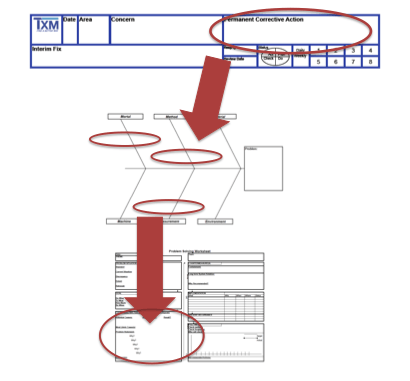Every company is at a different stage of the Lean Enterprise journey continuum and has a need for robust problem solving; at TXM, our Lean consultants see across the whole spectrum, from those just starting to realise there is a better way of doing things on daily basis, to those who have robust production flow and kanban systems.
A key transition step from “implementing” Lean to it becoming a way of daily manufacturing life is how we build problem solving into everything we do.
Everyday Problem Solving
The TXM concern strips provide a forum for everyday highlighting and addressing issues that arise at the production cell level.
The best training we can offer our operators is the skills to identify problems and come up with possible solutions. This helps to embed responsibility to the team for their own issues.
Including a review of the concern strips into the morning meetings keeps the focus on problem solving.
A weekly deep dive into the cells concern strips is also needed so the greater support network can help the cell develop robust, root cause corrective actions.

Developing Robust, Root Cause Corrective Actions
While concern strips are great to improve visibility of daily issues, they are not sufficient to delve into all of the factors that may have influenced that problem. This is where the fishbone diagram and 5 Whys are also needed.
Fishbone diagrams, developed by cross functional teams allow all of the issues which may contribute to a problem to be flushed out. The top two or three items can then be subjected to the 5 Why process, diving deeply into why ash situation has arisen.
Once the most likely root cause and a possible corrective action has been established, the concern strip is used to monitor how well the solution has fixed the problem.
What Steps are Required to Begin with Problem Solving
Once daily meetings have been going well for a few weeks, it is time to introduce concern strips to your manufacturing cells. Your lean consultant can help you with setting up the infrastructure and logistics. Documenting your problem solving process and training all involved is as critical in problem solving as with any of the other lean tools.
And remember, as the Lean Enterprise Institute points out:
Sustaining a lean transformation requires continuous problem solving by everyone in the company. Success hinges on how well we teach and apply a robust, shared problem-solving method at all levels to incorporate “evolutionary learning” into the company culture.
Visit our E-Store to Purchase Concern Strips to Help Solve Problems in Your Business





